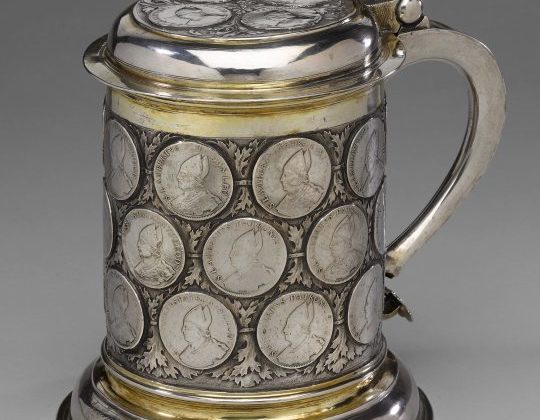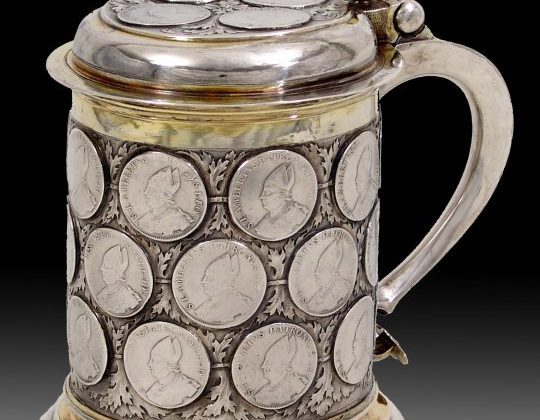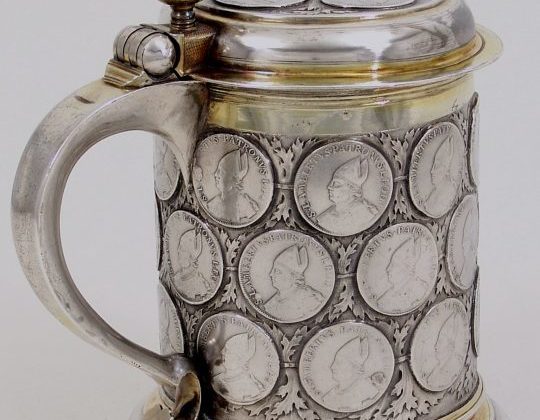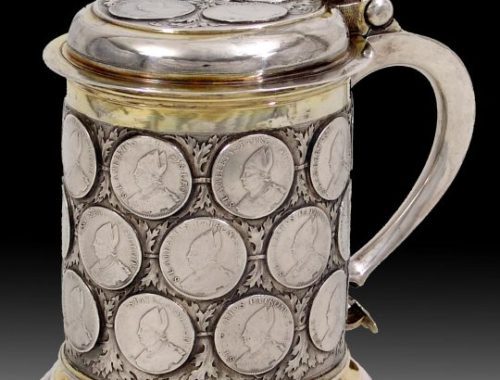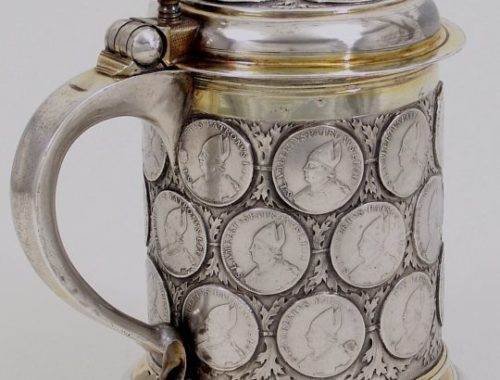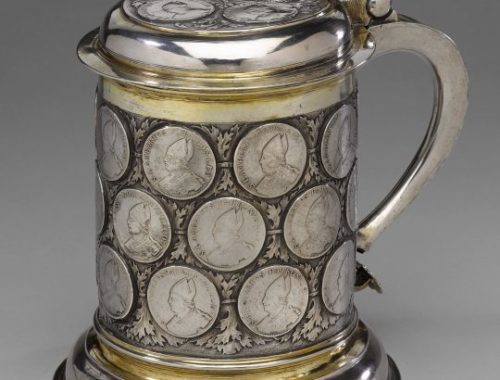Object Number: #101
Berlin, ca. 1695
Daniel Männlich der Ältere (1625-1701)
City hallmark: a bear for Berlin ca. 1695 (Rosenberg nr. 1148; Scheffler nr. 4b)
Maker’s mark: monogram “DM” in a round shield for Daniel Män(n)lich the Elder (Rosenberg nr. 1171; Scheffler nr. 141)
Coat of arms: on the coins, of the diocese of Liège and engraved on the foot the coat of arms of Courtrai (Neubecker 1974: 48)
Height: 25 cm (9,84 in.); weight: 2.300 gr.
Detailed Information
This large tankard is standing on a cylindrical foot, which is adorned with the coat of arms of the city of Courtrai. The body is decorated with 27 inserted coins arranged in three rows and depicting the profiled portrait of Saint Lambert, followed by an inscription and his name. Between the coins, artful acanthus leaves are embossed. Four more coins are inserted on the hinged lid and one in the bottom of the object. On the side of the tankard, there is an ear-shaped cast handle. The thumb rest is formed as a large, silver-gilt ball.
The coins
Without a doubt, are the insetted coins on this tankard the most interesting feature, of the object. An extremely rare minted taler (coin – patagon or patacon) is displayed from the period of the vacancy of the episcopal seat (sede vacante) and the diocese of Liège in the year 1694. The period of vacancy occurred in February 1694, when the prince-bishop John Louis of Elderen (1620-1694) died. His successor was the 23-year old Joseph Clemens of Bavaria (1671-1723), who became the 93rdprince-bishop of Liège in October 1694.
Displayed on the front side of the coins is the bust of Saint Lambert with a mitre and liturgical dress on his shoulders, around it the inscription: “S : LAMBERTVS ×PATRONVS ×LEOD :”. On the reverse is the coat of arms from the diocese of Liège: Bouillon, Franchimont, Looz, Hornes and the arms of Liège. Around these, a rosette with five leaves and the following inscription: “MONETA ×NOVA ×CAPLI × LEOD × SEDE ×VACANTE 16/94”.
Saint Lambert (ca. 636-ca. 700) was born in Maastricht and was a bishop of the city from c. 670, until his death, along with this he was also the patron of Liège. The bishop Saint Hubert (ca. 656/8-727) brought Lambert’s bones to Liège, when he transferred his bishop seat from Maastricht to Liège. It is important to note that the worship of Saint Lambert had been relatively widespread throughout Cologne.
Coins of the episcopal seat appeared for the first time in Liege in 1688. This new coin occurred when Maximilian Henry of Bavaria (1621-1688) Archbishop-Elector of Cologne, Bishop of Hildesheim and Bishop of Liège died. Maximilian was one of the first Wittelsbacher who occupied the bishop’s seat of Liege. Ever since, in each interregnum, there has been a sede vacantecoins produced. This brougth forwards the tradition of Liège, likewise it attributed the growing autonomy of the chapter (which is also suggested through the presence of ‘CAPLI’ on the coin).
Ordinarily the coins of sede vacantewere were minted when the diocesan bishop seat was vacant: due to the death, resignation or transfer of the bishop, or due to a loss of this office without the naming of a new bishop. Such coins were dealt as particular baroque art works on their own name.
The coins served as decorative elements on drinking vessels in the seventeenth and eighteenth century. They offered an ability to be represented luxuriously and fulfilled the pretence of the baroque princes, rulers and other ordering customers to secular and clerical power. The coins were reflected within all contemporary events.
A tankard with similar features which similarly immortalises a an important event, is made by the same Master – Daniel Männlich d.Ä. – belongs to the collection of the Hessisches Landesmuseum In Kassel: Coin Tankard, made of silver and partly-gilt, was made around 1679 and shows the Expulsion of the Swedish from Prussia during the Scanian War (1675-79), the so-called ‘Tankard of Brandenburg’.
The Production of the Tankard
The present tankard is not only aesthetically interesting, but also due to historical and cultural reasons very fascinating. The inserted coins of the tankard distinctly originate from Liège, whilst the coat of arms on the foot has a connection to Courtrai.
With regards to the character of such pieces, one can assume that the present tankard had been ordered by Maximilian II Emanuel, Elector of Bavaria (1662-1726) from the house of Wittelsbach. This tankard might have been an appropriate gift to offer to his younger brother Joseph Clemens.
Maximilian II was also the last governor of the Spanish Netherlands (1692-1706) as well as Margrave of Namur, Marquis Duke of Luxembourg, Brabant, Limburg and Guelders (1712-1714). His relatives from the House of Wittelsbach were also connected to Liège. Maximilian Henry of Bavaria was Prince-bishop of Liège from 1650 to 1688, while Joseph Clemens of Bavaria took up this title in 1694 with a confirmation of office from the Pope Innocent XII after difficult electoral disputes.
The two brothers, Max Emanuel and Joseph Clemens formed an alliance during 1695-1723. Notably, during the War of the Spanish Succession (1701-1714), they were on the side of the French and Spanish. Since the coronation of Joseph Clemens as prince-bishop of Liège, his brother would have had many occasions to offer such a gift, to him. The coronation of Joseph Clemens would have been an optimal time to offer such gift.
Besides that, the two brothers were active supporters of French and German artists. Their aesthetical criteria was in a sense influenced by different European, artistic tendencies and fashions.
The tankard – an object of the German baroque – is thus most probably connected to the history of the House of Wittelsbach and furthermore to the Diocese of Liège. Thereby the coat of arms of Courtrai could be explained through a later proprietor of the object.
Maker
Daniel Mänlich (or Männlich) the Elder was born in 1625 in Obersdorf, near Troppau (Silesia). Since 1650 he lived in Berlin, where his workshop was also located. In 1655, he became the goldsmith of the margrave of Brandenburg Frederick William (1620-1688) and since c. 1676, he was active as court goldsmith. Männlich died in 1701 in Berlin and his tomb is in the St. Nicholas’ church (Nikolaikirche) in Berlin. Männlich has made a series of coin drinking vessels, many of which being tankards. Together with the Berlin goldsmith Christian Lieberkühn (1669-1733), they became specialised makers in objects with coin decoration, and experienced lots oh high demand.
Literature
Neubecker, Ottfried, Wappenbilderlexikon: Dictionnaire héraldique = Encyclopaedia of heraldry, München: Battenberg, 1974.
DARIS, Joseph, Histoire du diocèse et de la principauté de Liège pendant le XVIIesiècle, t. II, Liège : Imprimerie et Lithographie Demarteau, 1877.
DENGIS, Jean-Luc, Les monnaies de la principauté de Liège. Volume III : De Gérard de Groesbeeck au rattachement à la France (1564-1794), Moneta : Wetteren, 2006.
HUYS, Jean-Philippe, ‘Deux mécènes de culture européenne en exil à l’aube du XVIIIe siècle. Les électeurs Maximilien II Emmanuel de Bavière et Joseph-Clément de Cologne, entre Pays-Bas méridionaux et royaume de France’, p. 155-169, dans MAËS, G. et BLANC, J., Institut de recherches historiques du Septentrion (éd.),Les échanges artistiques entre les anciens Pays-Bas et la France, 1482-1814. Actes du colloque international organisé par l’Institut de recherches historiques du Septentrion – UMR CNRS 8529 – Université de Lille 3 au Palais des Beaux-arts de Lille les 28-29-30 mai 2008, Brepols : Turnhout, 2010.
KEISCH, Christiane, Das große Silberbuffet aus dem Rittersaal des Berliner Schlosses, Kunstgewerbemuseum: SMPK, 1997.
PECHSTEIN, Klaus, ‘Münzgefäße‘ p. 205-219 In: Germanisches Nationalmuseum (éd.), Münzen in Brauch und Aberglauben. Schmück und Dekor – Votiv und Amulett – Politische und religiöse Selbstdarstellung, mit 342 Schwarzweiß-Abbildungen und 24 Farb-Tafeln, Mainz am Rhein: Verlag Philipp von Zabern, 1982.
SCHEFFLER, Wolfgang, Berliner Goldschmiede : Daten, Werke, Zeichen, Berlin : Hessling, 1968.


